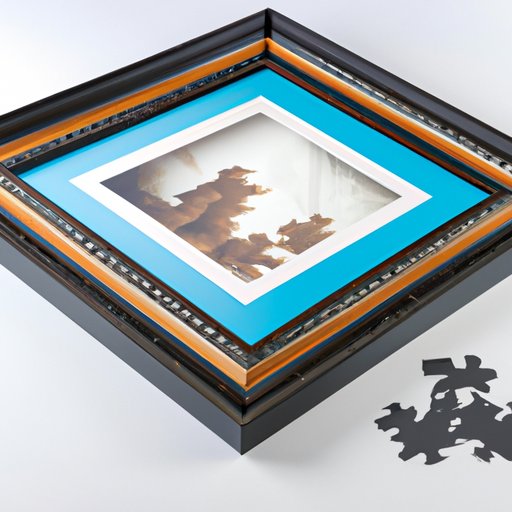I. Introduction
If you’re an avid puzzler, you know how rewarding it is to complete a challenging puzzle. But what happens after you’ve finished? While some may choose to disassemble and put the pieces back in the box, others want to show off their labor of love and preserve it in a beautiful way. That’s where framing a puzzle comes in.
In this article, we’ll guide you through the process of framing a puzzle, step-by-step. We’ll also provide some creative framing ideas, compare different methods for framing, highlight the work of puzzle framing artists, and explore the idea of puzzles as art.
II. Step-by-step guide
Framing a puzzle requires some careful planning and execution. Here are the steps:
Preparing the puzzle
Before you start framing your puzzle, you need to prepare it. First, carefully remove it from the surface you used to assemble it. Next, use a rolling pin or puzzle-friendly adhesive tape to flatten it out and secure any loose pieces. If your puzzle is dirty, you should gently clean it with a soft cloth to remove any dust or debris.
Choosing a frame
Choosing a frame is an important step in the framing process. Consider the size and style of the frame, as well as the color and texture of the frame itself. A neutral-colored frame will allow the colors of the puzzle to stand out, while a colorful frame can add visual interest to the display.
Mounting the puzzle
There are several methods for mounting a puzzle, including using adhesive, foam board, or framing strips. Adhesive is a common option, but can be difficult to remove if you ever want to take the puzzle out of the frame. Foam board is a sturdier option and provides a solid surface for the puzzle, but can be more expensive. Framing strips are a temporary mounting option that allows you to easily remove the puzzle from the frame.
III. Creative framing ideas
If you’re looking for a unique way to frame your puzzle, consider these creative ideas:
Creating a puzzle collage
Take a page from the art world and create a puzzle collage using multiple frames. This can be a great way to showcase a series of related puzzles, or simply to create a visually stunning display.
Using a shadow box
A shadow box can add depth and texture to a puzzle display, making it look like the puzzle is floating in space. This is a great option for 3D puzzles or puzzles with a lot of intricate detail.
IV. Compare and contrast framing methods
There are several methods for mounting a puzzle, each with its own pros and cons. Here are some things to consider:
Foam board mounting
Foam board is a sturdy and long-lasting option, but can be more expensive and difficult to cut to the exact size you need.
Glueing
Glueing a puzzle is a popular option, but can be messy and difficult to reverse if you ever want to take the puzzle out of the frame.
Dry mounting
Dry mounting can be a good option if you want to prevent the puzzle from shifting or moving over time, but can be expensive and difficult to reverse if needed.
V. Spotlight on puzzle framing artists
There are many talented puzzle framing artists out there who have made a name for themselves in the industry. Here are a few examples:
Geoffrey Gorman
Geoffrey Gorman is an artist who uses recycled materials to create unique puzzle frames that are both visually stunning and environmentally friendly.
Fredrix Puzzle Gallery
The Fredrix Puzzle Gallery specializes in creating custom frames for puzzles of all shapes and sizes.
VI. Puzzles-as-art
It’s no secret that puzzles can be a great way to exercise your brain and pass the time, but they can also be used to create unique works of art. Certain types of puzzles, such as 3D puzzles, can be used to create stunning pieces that can be displayed like traditional art.
Framing a puzzle can also be a meaningful way to preserve memories or create a one-of-a-kind decor item. By framing a puzzle, you can turn something that would otherwise be ephemeral into a permanent part of your home decor.
VII. Conclusion
In conclusion, framing a puzzle can be a fun and rewarding project for any puzzle enthusiast. With the right tools and techniques, you can turn your favorite puzzles into stunning works of art. Whether you’re looking for a traditional or non-traditional framing method, there are plenty of options to choose from.
We hope this article has provided you with the guidance and inspiration you need to achieve your puzzle framing goals.
